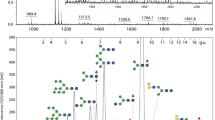Abstract
In the present work, glycoproteins in the excretory/secretory products of G. intestinalis were identified and the reactivity in serum of immunized mice with these molecules was evaluated by western blotting before and after chemical treatment or enzymatic deglycosylation. Glycoproteins of 58 and 63 kDa were revealed in E/S products after periodic acid-Schiff (PAS) stain. Studies of carbohydrate specificity using digoxigenin-labeled lectins, revealed the presence of O-glycans and N-glycans. Chemical treatment of excretory/secretory products with sodium meta-periodate or enzymatic deglycosylation with N-glycosidase F reduced the reactivity in serum for proteins of 36, 58 and 63 kDa, respectively. These results show the presence of glycoproteins in E/S products of G. intestinalis and suggest that the antibody response is directed against glycoepitopes. The expression of carbohydrate moieties in the E/S-G. intestinalis may play an essential role in the antibody response and may be a target for serodiagnosis or immune intervention in human giardiasis.




Similar content being viewed by others
References
Adam RD (2001) The biology of Giardia lamblia. Clin Microbiol Rev 14:447–475
Céu Sousa M, Gonçalves CA, Bairos VA, Poires-da-Silva J (2001) Adherence of Giardia lamblia trophozoites to INT-407 human intestinal cells. Clin Diagn Lab Immunol 8:258–265
Flanagan PA (1992) Giardia-diagnosis, clinical course and epidemiology: a review. Epidemiol Infect 109:1–22
Guimaraes S, Sogayar MI, Franco M (2003) Analysis of proteins from membrane and soluble fractions of Giardia duodenalis trophozoites of two Brazilian axenic strains. Rev Inst Med Trop Sao Paulo 44:239–244
Guha-Niyogi A, Sullivan DR, Turco SJ (2001) Glycoconjugate structures of parasitic protozoa. Glycobiology 11:45R–59R
Guy RA, Bertrand S, Faubert GM (1991) Modification of RPMI-1640 for use in vitro immunological studies of host-parasite interaction in giardiasis. J Clin Microbiol 29:627–629
Hiltpold A, Frey M, Hulsmeier A, Köhler P (2000) Glycosylation and palmitoylation are common modifications of Giardia variant surface proteins. Mol Biochem Parasitol 109:61–65
Jarvis LM, Pritchard DI (1992) An evaluation of the role of carbohydrate epitopes in immunity to Trichinella spiralis. Parasite Immunol 14:489–501
Jimenez JC, Fontaine J, Grzych JM, Dei-Cas E, Capron M (2004) Systemic and mucosal responses to oral administration of excretory/secretory (E-S) antigens from Giardia intestinalis. Clin Diagn Lab Immunol 11:152–160
Karr CD, Jarroll EL (2004) Cyst wall synthase: N-acetylgalactosaminyltransferase activity is induced to form the novel N-acetylgalactosamine polysaccharide in the Giardia cyst wall. Microbiology 150(Pt 5):1237–1243
Kaur H, Ghosh S, Samra H, Vinayak VK, Ganguly NK (2001) Identification and characterization of an excretory-secretory product from Giardia lamblia. Parasitology 123(Pt 4):347–356
Kaur H, Samra H, Ghosh S, Vinayak V, Ganguly NK (1999) Immune effector response to an excretory-secretory product of Giardia lamblia. FEMS Immunol Med Microbiol 23:93–105
Keister DB (1983) Axenic culture of Giardia lamblia in TYI-S-33 medium supplemented with bile. Trans R Soc Trop Med Hyg 77:487–488
Laemmli UK (1970) Cleavage of structural proteins during the assembly of the head of bacteriophage T4. Nature 227:680–685
Lloyd D, Ralphs JR, Harris JC (2002) Giardia intestinalis, a eukaryote without hydrogenosomes, produces hydrogen. Microbiology 148(Pt 3):727–733
Magne D, Favennec L, Chochillon C (1991) Role of cytoskeleton and surface lectins in Giardia duodenalis attachment to Caco2 cells. Parasitol Res 77:659–662
Moncada DC, Kammanadiminti SJ, Chadee K (2003) Mucin and Toll-like receptors in host defence against intestinal parasites. Trends Parasitol 19:305–310
Morelle W, Jimenez JC, Cienieski-Bernard C, Dei-Cas E, Michalski J.-C (2005) Characterization of the N-linked glycans of Giardia intestinalis. Glycobiology 15:549–559
Nash TE, Gillin FD, Smith PD (1983) Excretory-secretory products of Giardia lamblia. J Immunol 131:2004–2010
Ortega-Barria E, Ward HD, Evans JE, Pereira ME (1990) N-acetyl-d-glucosamine is present in cysts and trophozoites of Giardia lamblia and serves as receptor for wheatgerm agglutinin. Mol Biochem Parasitol 43:151–165
Paget TA, James SL (1994) The mucolytic activity of polyamines and mucosal invasion. Biochem Soc Trans 22:394S
Papanastasiou P, Mc Conville MJ, Ralton J, Köhler P (1997) The variant-specific surface protein of Giardia, VSP4A1, is a glycosylated and palmitoylated protein. Biochem J 322:49–56
Pegado MGF, de Souza W (1994) Role of the surface components in the process of interaction of Giardia duodenalis with epithelial cells in vitro. Parasitol Res 80:320–326
Schalling Henk DFH, van Leeuwen AW (1996) Carbohydrate epitopes on Haemonchus contotrtus antigens. Parasitol Res 82:38–42
Towbin H, Staehlin T, Gordon J (1979) Electrophoretic transfer of proteins from polyacrylamide gels to nitrocellulose sheets: procedure and some applications. Proc Nat Acad Sci USA 76:4350–4354
Ward HD, Lev BI, Kane AV, Keusch GT, Pereira ME (1987) Identification and characterization of taglin, a mannose 6-phosphate binding, trypsin-activated lectin from Giardia lamblia. Biochemistry 29:8669–8675
Ward HD, Alray J, Lev BI, Keusch GT, Pereira ME (1988) Biology of Giardia lamblia. Detection of N-acetyl-d-glucosamine as the only surface saccharide moiety and identification of two distinct subsets of the trophozoites by lectin binding. J Exp Med 167:73–88
Woodward M, Young W Jr, Bloogood R (1985) Detection of monoclonal antibodies specific for carbohydrate epitopes using periodate oxidation. J Immunol Methods 78:143–153
Acknowledgements
This research was developed in the framework of collaboration between ECOPA (EA-3609—Lille-2 University) groups at the Institute Pasteur of Lille (IFR-17) and UMR 8576 Laboratory of Structural and Functional Glycobiology (CNRS and University of Lille 1), France. Juan C. Jiménez was supported by a fellowship from “Fondo Nacional de Ciencia, Tecnología” e Innovación (FONACIT) and “Consejo de Desarrollo Científico y Humanístico” (Universidad Central de Venezuela). We thank Dr. Marian Ulrich for her critical revision and correction on the manuscript.
Author information
Authors and Affiliations
Corresponding author
Rights and permissions
About this article
Cite this article
Jiménez, J.C., Morelle, W., Michalsky, JC. et al. Excreted/secreted glycoproteins of G. intestinalis play an essential role in the antibody response. Parasitol Res 100, 715–720 (2007). https://doi.org/10.1007/s00436-006-0339-0
Received:
Accepted:
Published:
Issue Date:
DOI: https://doi.org/10.1007/s00436-006-0339-0




